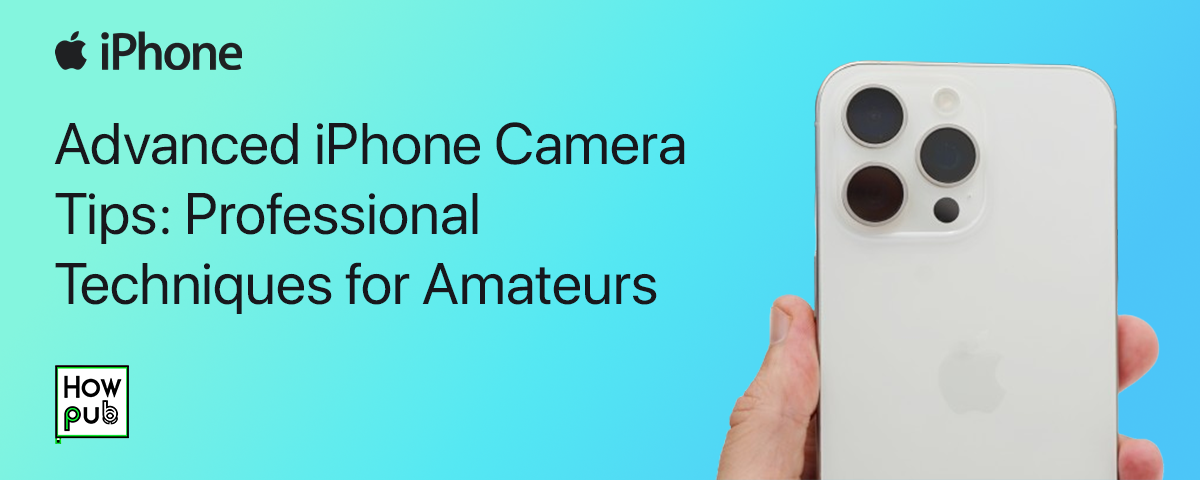Introduction
The iPhone is a powerful tool for photography, offering advanced camera features that can help amateurs achieve professional-quality results. Whether you're looking to take stunning portraits, capture action shots, or explore the world of macro photography, the iPhone's camera capabilities are more than up to the task. This guide will provide you with advanced iPhone camera tips and techniques, making it easy for anyone to elevate their photography skills.
Understanding Your iPhone Camera Features
Before diving into advanced techniques, it's important to understand the camera features available on your iPhone. Knowing how to use these features effectively can significantly improve the quality of your photos.
1. Camera Modes and When to Use Them
The iPhone offers several camera modes designed for different types of photography. Here’s a quick overview of the most important ones:
- Photo Mode: The default mode for taking still photos. Ideal for general photography, capturing clear and sharp images.
- Portrait Mode: Uses depth-effect technology to blur the background, focusing on the subject to create professional-looking portraits with a shallow depth of field. Perfect for taking headshots and close-up portraits.
- Night Mode: Automatically activates in low-light conditions, allowing you to capture bright, clear photos without using a flash. Ideal for evening and night-time photography.
- Pano Mode: Allows you to capture wide, sweeping landscapes or tall buildings by stitching together multiple images. Best used when you want to capture a larger field of view.
- Video and Slo-Mo: Useful for capturing motion, with the option to slow down the footage for dramatic effects.
Tip: Experiment with each mode to understand its capabilities and use the one that best suits your shooting environment.
As you explore the various camera modes on your iPhone, enhance your overall experience by improving your iPhone's audio quality, especially when recording videos or capturing moments with sound.
2. Advanced Camera Settings for Better Control
The iPhone camera settings provide several options to enhance your photos:
- HDR (High Dynamic Range): Combines multiple exposures to create a single image with better detail in both the shadows and highlights. Use HDR in high-contrast scenes to capture more detail.
- Grid: Helps align your shots using the rule of thirds, a fundamental principle in photography that improves composition. Enable it by going to Settings > Camera > Grid.
- Live Photos: Captures 1.5 seconds of motion and sound before and after you take a photo, bringing your images to life. Can be toggled on and off directly from the Camera app.
- Flash: Use sparingly as natural light is often more flattering. The flash can provide additional lighting in very low-light situations.
- Exposure Adjustment: Allows you to manually adjust the brightness of your photo by sliding your finger up or down on the screen after tapping to focus. This feature is useful for controlling the lighting in your photos.
While mastering these advanced camera settings, it's also important to enhance your iPhone's security with two-factor authentication to keep your device and photos safe.
Advanced iPhone Camera Tips and Techniques
Now that you're familiar with the basic features, let's dive into some advanced tips to help you take your iPhone photography to the next level.
1. Mastering Focus and Exposure for Sharp Photos
Achieving sharp, well-exposed photos involves mastering focus and exposure settings. Here's how you can do it:
- Tap to Focus: Tap on the screen to select your focus point. This tells your iPhone where to focus, ensuring that the subject is sharp.
- Adjust Exposure: After tapping to focus, slide your finger up or down to adjust the exposure. This controls the brightness of your photo, helping you capture the perfect lighting.
- Lock Focus and Exposure: To lock focus and exposure, press and hold on the screen until you see "AE/AF Lock." This is particularly useful when shooting in changing light conditions or if you want to maintain focus on a moving subject.
Pro Tip: Use focus and exposure lock to maintain consistent settings, especially in challenging lighting conditions like sunsets or brightly lit rooms with shadows.
As you sharpen your photography skills with focus and exposure settings, check out these essential iPhone tips for travelers to capture stunning photos while on the go.
2. Using Burst Mode for Action Shots
Burst Mode is perfect for capturing fast-moving subjects, like children playing or sports events. It takes multiple photos in quick succession, allowing you to choose the best shot.
- How to Use Burst Mode: Open the Camera app, swipe to Photo Mode, and press and hold the shutter button (or press and hold the volume up button) to start taking a burst of photos.
- Review and Select: Go to your Photos app, find the burst, and tap Select... at the bottom. Browse through the shots and pick the best ones.
Pro Tip: Burst Mode is excellent for capturing unexpected moments or fast actions. Always keep your iPhone steady or use a tripod for the best results.
While perfecting your action shots with Burst Mode, explore how to customize your iPhone widgets for a more personalized and efficient user experience.
3. Experimenting with Depth in Portrait Mode
Portrait Mode is not just for taking portraits. You can use it to create a shallow depth of field in any photo, making the subject stand out against a blurred background.
- Adjust Depth Control: After taking a photo in Portrait Mode, tap Edit and adjust the depth control slider to increase or decrease the background blur. This allows you to customize the intensity of the bokeh effect.
- Lighting Effects: Experiment with different lighting effects available in Portrait Mode to add dramatic effects or simulate professional studio lighting.
Pro Tip: Use Portrait Mode to focus on small details, like flowers or food, to create a dramatic depth-of-field effect.
As you experiment with depth and lighting in Portrait Mode, explore third-party apps that can further enhance your photography and editing options on your iPhone.
4. Mastering Low-Light Photography with Night Mode
Night Mode is a game-changer for low-light photography, allowing you to capture detailed photos even in dim lighting.
- Automatic Activation: Night Mode turns on automatically in low-light conditions. You can see the Night Mode icon (a crescent moon) at the top of the screen.
- Adjust Exposure Time: Tap the Night Mode icon and use the slider above the shutter button to increase the exposure time. Longer exposure times allow more light to enter the camera, but be sure to keep the iPhone steady to avoid blurry photos.
- Use a Tripod: For the best results in Night Mode, use a tripod or steady surface to keep the iPhone still during the longer exposure.
Pro Tip: For creative night shots, try using Night Mode with moving subjects (like cars) to create light trails and dynamic compositions.
As you capture stunning low-light photos with Night Mode, discover how to use Find My Friends and Family Sharing to stay connected with loved ones while out exploring or photographing.
5. Creating Stunning Panoramas
Panorama Mode is perfect for capturing wide landscapes or tall buildings in one shot.
- How to Use Pano Mode: Open the Camera app, swipe to Pano, and tap the shutter button. Move your iPhone slowly in the direction of the arrow, keeping the arrow aligned with the guide.
- Steady Hands: Keep your hands steady and move the iPhone slowly to avoid distortions in the final image.
Pro Tip: Use Panorama Mode vertically to capture tall subjects like skyscrapers or waterfalls, providing a unique perspective.
While you're capturing breathtaking panoramas, learn how to enhance the accuracy of Find My iPhone to keep your device secure while you're out exploring new locations.
6. Editing Your Photos for Professional Quality
Editing is a crucial step in turning a good photo into a great one. The iPhone's Photos app provides powerful editing tools to enhance your images.
- Use Auto-Enhance: Tap the Auto button to let the Photos
app adjust exposure, contrast, brightness, and more. This is a quick way to improve your photo with minimal effort.
- Manual Adjustments: Use the Edit feature to manually adjust light, color, and black & white settings. You can fine-tune exposure, shadows, highlights, and more to achieve the desired look.
- Filters and Effects: Experiment with different filters to add a unique style to your photos. You can adjust the intensity of each filter to find the perfect balance.
Pro Tip: Always save a copy of the original photo before making extensive edits, allowing you to revert if needed.
While enhancing your photos to professional quality, take a look at this guide to Apple Health to ensure you're also optimizing your well-being as you enjoy your photography journey.
Conclusion
The iPhone camera is a powerful tool that offers numerous features to help you take stunning photos. By understanding and utilizing these advanced tips and techniques, you can elevate your photography skills from amateur to professional. Experiment with different modes, master the settings, and practice editing to make the most out of your iPhone’s camera capabilities.



